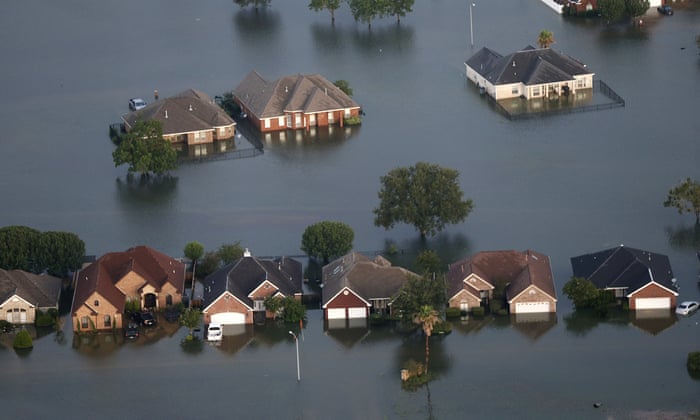The real villains in Harvey flood: urban sprawl and the politicians who allowed it
Billy Fleming
| There’s never been a more important time to understand the political machinations that led to Harvey’s destructiveness – and dismantle them |
|
‘The swamps and wetlands that once characterized Houston’s hinterland have been replaced with strip malls and suburban tract homes.’ Photograph: Gerald Herbert/AP |
|
Houston’s catastrophic flood will be framed by leaders in Texas as an unforeseeable act of God. It isn’t. Houston’s unfettered sprawl into the marshland of southeast Texas was a conscious choice by policymakers. So was building a global city on a slowly submerging swamp. Both were decisions that led to disaster. Houston has quietly become our fourth largest and fastest-growing city, due in large part to cheap housing. But the latter has come at an exorbitant cost to its safety. The swamps and wetlands that once characterized Houston’s hinterland have been replaced with strip malls and suburban tract homes. Those landscapes once served as a natural flood protection system for the city. Research shows that, if they hadn’t been filled and developed, Harvey’s impact would have been lessened. Sam Brody and his colleagues at Texas A&M University in Galveston have been predicting an event like this for nearly a decade. That their work went unheeded by Texas policymakers should not be forgotten. Worse, a generation of civic leaders have completely deregulated Houston’s land development market. In that process, they helped build a far-flung network of poor neighborhoods on top of a swamp. In Houston, there is a simple truth: the poorer you are, the closer you live to a petrochemical plant and the likelier your home is to flood. There will be an impulse to elide past the political choices that led us to this point. We shouldn’t allow our politicians to use the use Harvey’s victims as human shields by pronouncing that now is not the time for criticism or blame. There’s never been a more important time to understand the political machinations that led to Harvey’s destructiveness, and to do everything in our power to dismantle them. Much has been made about Ted Cruz’s vote against Sandy relief funding in 2013. His hypocrisy is fair game for political journalists. But the greater failure of Cruz and John Cornyn is in not seeking funding for a solution to the world’s most predictable disaster before Harvey made landfall. Much more should be made of Texas Land Commissioner, George P Bush’s failings. As head of the General Land Office, Bush holds a unique and singular power to plan, engineer, and manage the Texas coastline. In fact, he’s yet to fully spend the more than $3bn allocated to the General Land Office after Ike. Given that Bush is likely to lead the Harvey recovery, it’s fair for us to question whether or not he’s up to the task. The question that he and every Houstonian must ponder now is how their recovery can be better than those that followed Ike and Katrina. Erecting a massive barrier system akin to the $14.5bn behemoth rimming New Orleans won’t be enough. But it will be the impulse of every politician eager to project an image of strength and resilience in Harvey’s aftermath – and to expand their political brand by becoming known as Houston’s savior. Built in 2014 and already suffering a potentially catastrophic pump failure, the New Orleans surge barrier is emblematic of the greater infrastructural challenge facing coastal cities in the US. Coastal infrastructure is incredibly expensive to build and nearly impossible to maintain, especially when you realize that the maintenance is borne entirely by local governments – none of which have the financial or technical capacity to do so effectively. Some have already begun to point to Holland, where the world’s most complex flood control system operates, and to proclaim that if the Dutch do it, so can the United States. This simply isn’t true. The Netherlands has a much higher tax rate, giving it more resources per person to invest in its infrastructure. Dutch storms are also less intense and bring lower surge heights and less rainfall than their American counterparts. For a lasting recovery, Houston will need to supplement whatever barrier system it builds with a broader, regional network of wetlands, retention ponds, and green infrastructure to restore the once-robust, natural flood protection lost to a half-century of urban sprawl. Designers have been calling for such an approach since Ike made landfall. Houston should look to New York’s landscape architect-led recovery process as a model worthy of consideration. A half-century of bad design choices and impotent planning led Houston to this crisis. Now, it’s up to a new generation of Houstonians to do what their predecessors could not – prepare the Magnolia City to rise up and meet its wetter future head on. Houston deserves the full, fair recovery that never came after Ike. They may not get another chance. Billy Fleming is research director for the Ian L McHarg Center at University of Pennsylvania School of Design, where he earned a PhD in City Planning. He is a co-author The Indivisible Guide and a co-creator of Data Refuge * This news iteam was originally posted on The Guardian. To read the original news story, click here. |

